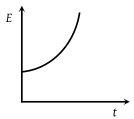A toy car of mass 5 kg moves up a ramp under the influence of force F plotted against displacement x. The maximum height attained is given by


1. ymax = 20 m
2. ymax = 15 m
3. ymax = 11 m
4. ymax = 5 m


The graph between the resistive force \(F\) acting on a body and the distance covered by the body is shown in the figure. The mass of the body is \(25\) kg and the initial velocity is \(2\) m/s. When the distance covered by the body is \(4\) m, its kinetic energy would be:
1. \(50\) J
2. \(40\) J
3. \(20\) J
4. \(10\) J
A particle of mass 0.1 kg is subjected to a force which varies with distance as shown in fig. If it starts its journey from rest at x = 0 , its velocity at x = 12 m is
(1) 0 m/s
(2)
(3)
(4) 40 m/s
The relation between the displacement \(X\) of an object produced by the application of the variable force \(F\) is represented by a graph (as shown in the figure below). If the object undergoes a displacement from \(X=0.5\) m to \(X=2.5\) m the work done will be approximately equal to:
1. 16 J
2. 32 J
3. 1.6 J
4. 8 J
A particle is given a constant horizontal velocity from height h. Taking g to be constant every where, kinetic energy E of the particle w. r. t. time t is correctly shown in
(1)
(2)
(3)
(4)
The adjoining diagram shows the velocity versus time plot for a particle. The work done by the force on the particle is positive from
(1) A to B
(2) B to C
(3) C to D
(4) D to E
A particle which is constrained to move along the x-axis, is subjected to a force in the same direction which varies with the distance x of the particle from the origin as . Here k and a are positive constants. For , the functional form of the potential energy U(x) of the particle is-
(1)
(2)
(3)
(4)
A force F acting on an object varies with distance x as shown here. The force is in newton and x in metre. The work done by the force in moving the object from x = 0 to x = 6 m is
(1) 4.5 J
(2) 13.5 J
(3) 9.0 J
(4) 18.0 J
The potential energy of a system is represented in the first figure. the force acting on the system will be represented by:
| 1. |  |
2. |  |
| 3. |  |
4. |  |
A particle, initially at rest on a frictionless horizontal surface, is acted upon by a horizontal force which is constant in size and direction. A graph is plotted between the work done (W) on the particle, against the speed of the particle, (v). If there are no other horizontal forces acting on the particle the graph would look like
1.
2.
3.
4.
























